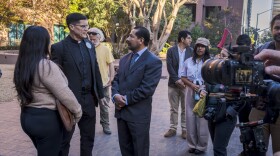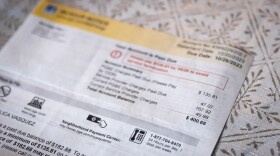For well over a decade, San Diego has been debating what kind of housing to allow around the Blue Line trolley stations in Clairemont. Now, almost four years after the trolley's arrival in the neighborhood, city planners have an answer.
City staff, who work under the direction of Mayor Todd Gloria, recently released a new draft of the Clairemont Community Plan Update.
The proposal would allow taller buildings and higher density housing in the neighborhood's inland core. Shopping centers with big box stores and surface parking lots could be redeveloped into a mix of apartments, retail, offices and public plazas.
Lifelong Clairemont resident Ian Grooms, who served two years on the Clairemont Community Planning Group, said he's thrilled at the prospect of more housing — and more neighbors.
"I think it's important for us as a city to turn underutilized parking spaces into possibilities," Grooms said. "There are so many people who can't even afford to live in Clairemont. They can't afford this million dollar neighborhood."
But despite all the additional density planned for central Clairemont, the vast majority of the neighborhood would remain zoned for single-family homes — including most of Bay Park, where many homes are within a comfortable walking distance of the trolley.
The city's Planning Commission is holding a public workshop on the Clairemont Community Plan Update on Aug. 28. The plan is expected to go before the San Diego City Council in the fall.
"I feel it's more of a political capitulation than it is smart policy making," said Nicole Caprez, executive director of the nonprofit Climate Action Campaign.
Capretz recalls working in the City Council District 2 office in 2014, when planners briefly considered an increase to the height limit in Bay Park. Taxpayers were spending $2 billion on the Blue Line trolley extension, and the city wanted to allow more people to live within walking distance of that transit.
But the backlash from homeowners, fearful of increased traffic and protective of their views of Mission Bay, was fierce.
"People's belief in the worst case scenario, from their perception, drove the conversation," Capretz said. "And I think then it made the city uncomfortable and nervous and shrink back."
In 2019, the city adopted targeted zoning plans that allow higher-density development west of the Balboa Avenue Station in Pacific Beach, as well as a handful of properties immediately adjacent to the Clairemont Drive Station. The new plan would also allow development on the Balboa Avenue Station parking lot. But apartments — even townhomes — would still be illegal on properties just a five-minute walk to the trolley.
"The city has goals around housing, which they're nowhere close to meeting," Capretz said. "The city has goals for how they're going to reduce carbon pollution, which they're nowhere close to meeting. And we have this deepening affordability crisis. And so when you marry all of these challenges, the city can't really respond with small fixes."
City Planning Director Heidi VonBlum said the single-family homes near the trolley are already less attractive to developers because they're relatively small properties that wouldn't yield much housing, even if they were zoned for higher density. The walk from the trolley into Bay Park is also uphill, she added.
"If we were starting from scratch, we would be planning for some mid- to higher-density areas along the transit corridor," VonBlum said. "This is what we have decided to bring forward here. That doesn't mean that there won't be other opportunities in the future to reconsider additional growth opportunities, targeted in the right places, across the city in single-family zones."
San Diego is far from alone among California cities that ban apartments near rail stops. That's why state lawmakers, frustrated by the slow pace of homebuilding, have proposed SB 79. The bill, which awaits a vote in the state Assembly, would overrule local zoning to allow apartments of up to six stories within a quarter mile of light rail stops.
Earlier efforts from the state legislature to require cities to allow transit-oriented development failed in 2018, 2019 and 2020. Marcella Bothwell, chair of Neighbors for a Better California, said SB 79 is a top-down mandate and an insult to local planners who have spent years on the Clairemont plan update.
"When you're in Sacramento, you don't know what's going on on the ground," Bothwell said. "You don't know the topography. You don't know the conditions or concerns. And so you have to listen to people who are living there."
Grooms, a recent college graduate, developed an interest in urban planning after watching neighbors rise up in opposition to a number of affordable housing developments in Clairemont. But the neighborhood's worst fears have not been realized, he said, and the developments have added nicer landscaping and paid for road improvements.
"They were concerned that (affordable housing) was going to ruin the character of our neighborhoods," Grooms said. "And then what is it doing? It's actually providing a roof over people's heads. It's allowing people who are at risk of homelessness to have a home at night."








